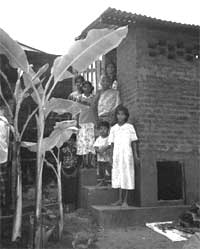Thinking clean
 Paul Calvert, a Kerala-based ecological sanitation expert, has proved that ecosan approach can work in areas where water is scarce. In 1995, he built his first such ecosan toilet in a coastal village of Kerala. At that time, 80 per cent households of the village had no latrines. Moreover, at least 50 per cent of families were consuming water that was contaminated due to open-air defecation. However, the main impetus for Calvert was to provide women with some privacy.
Paul Calvert, a Kerala-based ecological sanitation expert, has proved that ecosan approach can work in areas where water is scarce. In 1995, he built his first such ecosan toilet in a coastal village of Kerala. At that time, 80 per cent households of the village had no latrines. Moreover, at least 50 per cent of families were consuming water that was contaminated due to open-air defecation. However, the main impetus for Calvert was to provide women with some privacy.
Since the water table of the area was quite high and prone to tidal flooding, building pit latrines was not considered feasible. Moreover, building a sewerage system was out of the question. Therefore, the best option was to build ecosan toilets.
Calvert's ecosan toilet consists of a slab built over two vaults. The slab has a hole over each vault for the faeces to drop in and a funnel-like device to collect the urine. Between the two holes is a small drain over which anal cleaning takes place. The anal cleaning water and the urine is together drained into a plant bed.
After each use, a small amount of ash is sprinkled down the faeces hole to facilitate the drying process. The two holes are used on a rotational basis for six-months. Before use, each hole is covered with straw to facilitate decomposition. After six months, the decomposed faeces is used as a soil conditioner.
Though these ecosan toilets are as economical as any other sanitation system, Calvert declines to comment on the cost. "Many people judge things by the cost of the hardware. I want to promote the approach, not the hardware cost," he says. He has built ecosan toilets in other countries as well. His system can be used in high water table areas; dry, water scarce areas; rocky sites and flood plains.
Related Content
- Global electricity review 2024
- Making clean energy transitions more inclusive: evidence, knowledge gaps, and policy options in low-income economies
- Gender equality and social inclusion in a just energy transition
- Fast-tracking road transport decarbonisation through a new ‘international sustainable transport alliance’
- Solar pivot: a massive global solar boom is disrupting energy markets and speeding the transition
- Order of the Madras High Court regarding use of plastics by food manufacturers to pack their products in packages, 12/08/2022
